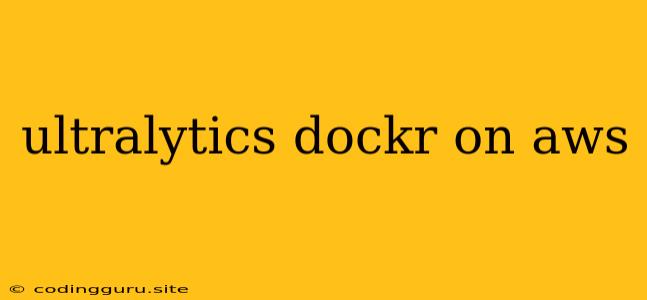Running Ultralytics YOLOv8 on AWS with Docker: A Guide
Deploying powerful deep learning models like Ultralytics YOLOv8 requires robust infrastructure. AWS (Amazon Web Services) offers a comprehensive cloud platform with a range of services ideal for training and deploying such models. This guide will walk you through how to leverage the power of Docker and AWS to effectively run Ultralytics YOLOv8.
Why Docker and AWS?
- Docker: Docker simplifies the packaging and deployment of applications, ensuring consistent environments across different systems. This is crucial for models like YOLOv8, which rely on specific libraries and dependencies.
- AWS: AWS offers a scalable, reliable, and cost-effective cloud environment, making it an excellent choice for deep learning workloads.
Setting Up Your AWS Environment
- AWS Account: Start by creating an AWS account if you haven't already.
- EC2 Instance: Launch an Amazon EC2 instance. Choose a suitable instance type based on your model's requirements. For YOLOv8, a GPU-enabled instance (like p3 or g4dn) is recommended for faster training and inference.
- Security Groups: Configure inbound and outbound rules for your EC2 instance. This ensures that your instance can communicate with Docker and other relevant services.
Installing Docker on Your AWS EC2 Instance
- Connect to Your Instance: Establish an SSH connection to your EC2 instance using a terminal or an SSH client.
- Install Docker: Follow the official Docker installation instructions for your Linux distribution. You can usually install Docker using the package manager, for example,
sudo apt update && sudo apt install docker-ce docker-ce-cli containerd.ioon Ubuntu. - Verify Installation: Run
docker --versionto confirm successful installation.
Building Your Docker Image for Ultralytics YOLOv8
- Dockerfile: Create a
Dockerfilein your project directory. This file instructs Docker how to build your image. - Base Image: Begin with a suitable base image. The official
nvidia/cudaimage is a good option, providing CUDA support for GPU acceleration. - Install Dependencies: Install essential packages like Python, pip, and OpenCV. You can install these using
RUN apt-get update && apt-get install -y python3-pip python3-opencv. - Install YOLOv8: Install Ultralytics YOLOv8. The easiest way is to install it from PyPI by using
RUN pip install ultralytics. - Add Your Code and Data: Copy your project code, training data, and any necessary configuration files into the Docker image.
Here's an example Dockerfile:
FROM nvidia/cuda:11.8.0-cudnn8-devel-ubuntu20.04
# Install essential packages
RUN apt-get update && apt-get install -y python3-pip python3-opencv
# Install YOLOv8
RUN pip install ultralytics
# Copy your project code and data
COPY . /app
# Set the working directory
WORKDIR /app
# Define the entry point for your container
ENTRYPOINT ["python", "train.py"]
Building and Running the Docker Image
- Build the Image: From your terminal, run the following command, replacing
your-image-namewith a descriptive name:docker build -t your-image-name . - Run the Container:
This command runs the Docker container, maps port 8888 to your host machine, and makes it interactive.docker run -it -p 8888:8888 your-image-name
Deploying Your YOLOv8 Application on AWS
- AWS Elastic Container Service (ECS): Utilize AWS ECS for containerized application orchestration. ECS simplifies container deployment, scaling, and management.
- ECS Task Definition: Define the resources, container image, and network configuration for your YOLOv8 application.
- ECS Service: Create an ECS service that utilizes your task definition and runs your containers.
- Load Balancer: Configure an Elastic Load Balancer to handle incoming requests and distribute them across multiple instances, providing high availability.
Advantages of Using Docker and AWS for YOLOv8
- Scalability: AWS provides the infrastructure to scale your training and inference workloads.
- Cost-Effectiveness: AWS's pay-as-you-go pricing model allows you to optimize costs based on your specific needs.
- Security: AWS provides robust security features to protect your data and applications.
- Portability: Docker allows you to easily move your YOLOv8 application between different environments.
Conclusion
Running Ultralytics YOLOv8 on AWS with Docker offers a streamlined and efficient approach for training and deploying powerful object detection models. By leveraging the power of Docker and AWS, you can enjoy scalability, cost optimization, and robust security features, ensuring a reliable and performant deep learning environment.
